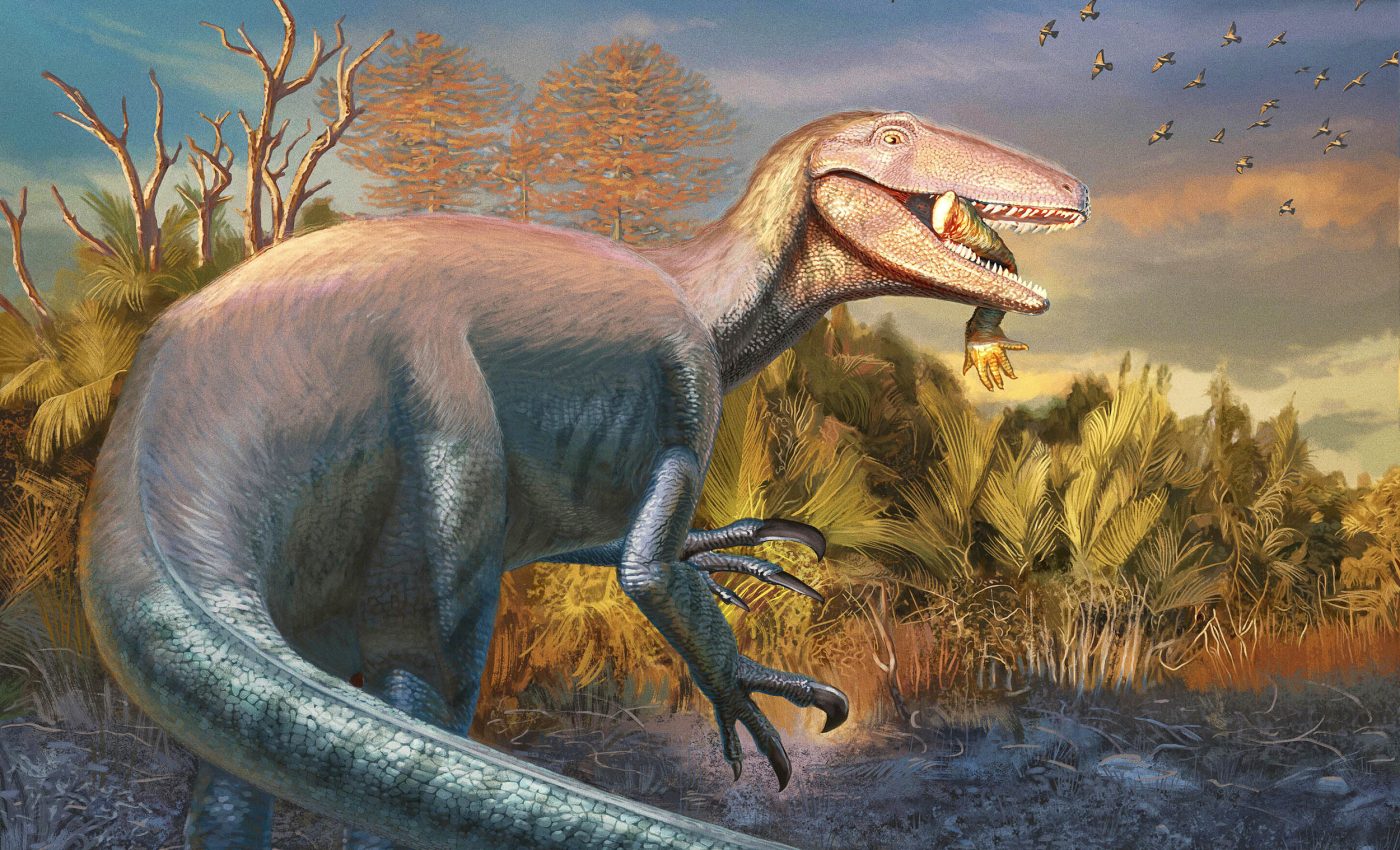
New dinosaur species discovered with a crocodile arm in its mouth
A new dinosaur species from Patagonia, Joaquinraptor casali, steps out of the shadows with a telltale clue clenched in its jaws: the bone of an ancient crocodile relative.
The animal belonged to the megaraptorans, a puzzling clan of fleet, sharp-clawed predators that prowled southern lands near the end of the Age of Dinosaurs.
At an estimated 23 feet (seven meters) long, the newcomer helps explain how these hunters lived, what they ate, and how they evolved.
In rocks dated to roughly 66–70 million years ago, researchers uncovered one of the most complete megaraptoran skeletons yet known.
The bones include parts of the skull, arms, legs, and tail, plus that crocodilian jaw pressed against a forelimb.
Together, they offer a rare look at an animal that died at least 19 years old on humid floodplains not long before the mass extinction.
Significance of Joaquinraptor casali
The discovery team reports the megaraptoran fossil as a new species, Joaquinraptor casali, from the Lago Colhué Huapi Formation in Argentine Patagonia.
The research adds crucial data to a group famous for long, narrow skulls and outsized forelimb weapons.
“Megaraptorans were known for their stretched-out skulls and ‘huge and very powerful claws,’” said Lucio Ibiricu of the Patagonian Institute of Geology and Paleontology, who was part of the discovery team.
Outside experts agree on the importance of the find. This latest member of the megaraptoran clan “fills a major gap by providing one of the most complete skeletons yet,” said Federico Agnolin from the Argentine Museum of Natural Sciences Bernardino Rivadavia.
Dinosaur with weapons in hand
Megaraptorans roamed what is now South America, Australia, and parts of Asia, branching into multiple species over millions of years.
They were lightly built, long-legged, and armed. The hallmark was a forelimb fitted with curved claws large enough to rival the foot talons of other famous carnivores.
That anatomy hints at a hunting style that relied on reach, grip, and slashing strikes at close range. Because megaraptoran fossils are fragmentary, paleontologists struggle to determine their feeding habits and family-tree placement.
The new skeleton moves that debate forward. With overlapping bones from several regions of the body, it lets scientists test ideas about musculature, bite mechanics, and how the big claws were anchored and used.
The crocodile relative’s jaw found pressed against a forelimb adds a visceral detail: this animal interacted with large semi-aquatic prey, either as a hunter, a scavenger, or both.
Joaquinraptor casali‘s lifestyle
Growth marks in bone hint that Joaquinraptor casali reached at least 19 years of age. That is a respectable lifespan for a mid-sized predator living in Late Cretaceous wetlands.
The environment was warm and lush, crisscrossed by rivers that flooded, shifted channels, and left behind layers of silt and sand – the same sediments that entombed the skeleton.
Whether this dinosaur was the apex hunter of its neighborhood is still an open question, but its size, speed and weaponry suggest it competed near the top.
Dinosaur family tree
Where megaraptorans fit evolutionarily remains controversial. Different studies have placed them close to tyrannosaurs, near allosaurs, or in their own specialized branch within the broader group of theropods.
That uncertainty stems from incomplete fossils that emphasize different traits and point in different directions.
The new specimen tightens those comparisons. Skull pieces sharpen measurements of bite and snout shape. Limb bones refine estimates of stride and arm power.
Tail elements speak to balance and agility. Each line of evidence narrows options for where Joaquinraptor casali and its kin belong on the dinosaur tree.
True identity of Joaquinraptor casali
The bones from Lago Colhué Huapi carry a mix of megaraptoran hallmarks and distinctive features that set the animal apart. That combination – shared traits plus unique details – is what signals a new species.
In this case, the team compared the skull and limb shapes to known megaraptorans from Patagonia and beyond. They found a pattern that didn’t match any named species.
The completeness of the skeleton strengthens the case, because anatomies across the body tell a consistent story.
Ibiricu named the dinosaur in memory of his son, Joaquin. Scientific names often honor places or people connected to a discovery, but this one carries special poignancy.
“All children love dinosaurs, so he would probably be a fan too,” he said.
The tribute weaves a family’s loss into a creature’s scientific identity – a reminder that behind every fossil lie years of fieldwork, lab time, and lives that shape the work.
New dinosaur fossil, new questions
With a more complete megaraptoran in hand, researchers can revisit long-standing puzzles.
Did these predators rely more on their arms than their jaws during a kill? Were they sprinters that ambushed prey along river margins? How widespread were they in the final chapters of dinosaur history across Gondwanan continents?
Additional CT scans, microscopic bone studies, and biomechanical modeling will help answer those questions.
New digs in Patagonia and elsewhere may also turn up juveniles or even rarer traces like skin impressions that expand the picture further.
For now, Joaquinraptor casali puts sharper teeth – and even sharper claws – on a lineage that has eluded clear definition for decades.
It firmly anchors megaraptorans in time, place, and ecology with a fossil unusually generous in preservation. In paleontology, that’s gold.
The study is published in the journal Nature Communications.
—–
Like what you read? Subscribe to our newsletter for engaging articles, exclusive content, and the latest updates.
Check us out on EarthSnap, a free app brought to you by Eric Ralls and Earth.com.
—–













